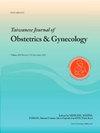评估子宫内膜瘤患者的致动脉粥样硬化指数:病例对照研究
IF 2
4区 医学
Q2 OBSTETRICS & GYNECOLOGY
引用次数: 0
摘要
材料和方法 本研究为回顾性、单中心、病例对照研究,共涉及 190 名妇女,包括 95 名病例组和 95 名对照组。研究计算了血液参数、血清泛免疫炎症值、全身免疫炎症指数、全身炎症反应指数等炎症指标,以及血浆致动脉粥样硬化指数(AIP)、卡斯泰利风险指数 I 和 II(CRI-I 和 II)、致动脉粥样硬化系数(AC)等致动脉粥样硬化指数。结果子宫内膜异位症患者血清脂质参数中的甘油三酯(TG)水平(103.09 ± 54.17 vs 77.52 ± 23.37,p < 0.001)和血浆致动脉粥样硬化指数(AIP)值(0.25 ± 0.24 vs -0.13 ± 0.19,p < 0.001)明显高于对照组。结论:我们的研究表明,子宫内膜异位症患者出现促动脉粥样硬化血脂谱和血浆动脉粥样硬化指数(AIP)升高的风险更高。鉴于子宫内膜异位症的诊断往往比较迟缓,而且患者长期处于这种疾病的影响之下,因此在临床随访期间应该对患者的动脉粥样硬化性心血管疾病进行评估。本文章由计算机程序翻译,如有差异,请以英文原文为准。
Evaluation of atherogenic indices in patients with endometrioma: A case-control study
Objective
To evaluate the cardiovascular risk status of patients with endometriosis using serum lipid parameters and atherogenic indices.
Materials and methods
The study was retrospective, single-centric, case-control study, involving a total of 190 women, including 95 cases and 95 control groups. Blood parameters, inflammatory markers as serum pan-immune-inflammation value, systemic immune-inflammation index, systemical inflammation-response index, and the atherogenic indices as Atherogenic Index of Plasma (AIP), Castelli Risk Index I and II (CRI-I and II), and the Atherogenic Coefficient (AC) were calculated.
Results
Triglyceride (TG) levels among serum lipid parameters (103.09 ± 54.17 vs 77.52 ± 23.37, p < 0.001) and Atherogenic Index of Plasma (AIP) values (0.25 ± 0.24 vs −0.13 ± 0.19, p < 0.001) were significantly higher in endometriosis patients than in the control group. Patients with endometriosis had 2.31 times higher high-risk AIP values (1.23–4.33, p = 0.008).
Conclusion
Our study indicates that patients with endometriosis are at a heightened risk for developing a proatherogenic lipid profile and an elevated atherogenic index of plasma (AIP). Given the often delayed diagnosis of endometriosis and the extended period of chronic exposure to the disease, patients should be evaluated for atherosclerotic cardiovascular diseases during clinical follow-ups.
求助全文
通过发布文献求助,成功后即可免费获取论文全文。
去求助
来源期刊

Taiwanese Journal of Obstetrics & Gynecology
OBSTETRICS & GYNECOLOGY-
CiteScore
3.60
自引率
23.80%
发文量
207
审稿时长
4-8 weeks
期刊介绍:
Taiwanese Journal of Obstetrics and Gynecology is a peer-reviewed journal and open access publishing editorials, reviews, original articles, short communications, case reports, research letters, correspondence and letters to the editor in the field of obstetrics and gynecology.
The aims of the journal are to:
1.Publish cutting-edge, innovative and topical research that addresses screening, diagnosis, management and care in women''s health
2.Deliver evidence-based information
3.Promote the sharing of clinical experience
4.Address women-related health promotion
The journal provides comprehensive coverage of topics in obstetrics & gynecology and women''s health including maternal-fetal medicine, reproductive endocrinology/infertility, and gynecologic oncology. Taiwan Association of Obstetrics and Gynecology.
 求助内容:
求助内容: 应助结果提醒方式:
应助结果提醒方式:


